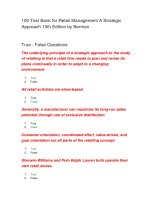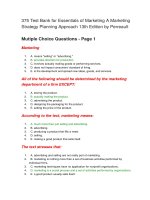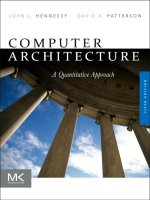Preview Marks’ Basic Medical Biochemistry A Clinical Approach (5th Edition) by Michael A. Lieberman Alisa Peet (2017)
Bạn đang xem bản rút gọn của tài liệu. Xem và tải ngay bản đầy đủ của tài liệu tại đây (4.13 MB, 191 trang )
AcquisitionsEditor:ShannonMagee
DevelopmentEditor:AndreaVosburgh
EditorialCoordinator:LaurenPecarich
MarketingManager:MichaelMcMahon
ProductionProjectManager:DavidOrzechowski
DesignCoordinator:JoanWendt
PrepressVendor:AbsoluteService,Inc.
FifthEdition
Copyright©2018WoltersKluwer
Copyright©2013,2009byLippincottWilliams&Wilkins,aWoltersKluwerbusiness.Allrightsreserved.
Thisbookisprotectedbycopyright.Nopartofthisbookmaybereproducedortransmittedinanyformor
byanymeans,includingasphotocopiesorscanned-inorotherelectroniccopies,orutilizedbyany
informationstorageandretrievalsystemwithoutwrittenpermissionfromthecopyrightowner,exceptfor
briefquotationsembodiedincriticalarticlesandreviews.Materialsappearinginthisbookpreparedby
individualsaspartoftheirofficialdutiesasU.S.governmentemployeesarenotcoveredbytheabovementionedcopyright.Torequestpermission,pleasecontactWoltersKluweratTwoCommerceSquare,
2001MarketStreet,Philadelphia,PA19103,viaemailat,orviaourwebsiteat
lww.com(productsandservices).
987654321
PrintedinChina
LibraryofCongressCataloging-in-PublicationData
Names:Lieberman,Michael,1950-author.|Peet,Alisa,author.
Title:Marks’basicmedicalbiochemistry:aclinicalapproach/MichaelLieberman,AlisaPeet;
illustrationsbyMatthewChansky.
Othertitles:Basicmedicalbiochemistry
Description:Fifthedition.|Philadelphia:WoltersKluwer,[2018]|Includesbibliographicalreferencesand
index.
Identifiers:LCCN2017016094|ISBN9781496324818
Subjects:|MESH:BiochemicalPhenomena|ClinicalMedicine
Classification:LCCQP514.2|NLMQU34|DDC612.1/111—dc23LCrecordavailableat
/>Thisworkisprovided“asis,”andthepublisherdisclaimsanyandallwarranties,expressorimplied,
includinganywarrantiesastoaccuracy,comprehensiveness,orcurrencyofthecontentofthiswork.
Thisworkisnosubstituteforindividualpatientassessmentbaseduponhealthcareprofessionals’
examinationofeachpatientandconsiderationof,amongotherthings,age,weight,gender,currentorprior
medicalconditions,medicationhistory,laboratorydata,andotherfactorsuniquetothepatient.The
publisherdoesnotprovidemedicaladviceorguidanceandthisworkismerelyareferencetool.Healthcare
professionals,andnotthepublisher,aresolelyresponsiblefortheuseofthisworkincludingallmedical
judgmentsandforanyresultingdiagnosisandtreatments.
Givencontinuous,rapidadvancesinmedicalscienceandhealthinformation,independentprofessional
verificationofmedicaldiagnoses,indications,appropriatepharmaceuticalselectionsanddosages,and
treatmentoptionsshouldbemadeandhealthcareprofessionalsshouldconsultavarietyofsources.When
prescribingmedication,healthcareprofessionalsareadvisedtoconsulttheproductinformationsheet(the
manufacturer’spackageinsert)accompanyingeachdrugtoverify,amongotherthings,conditionsofuse,
warningsandsideeffectsandidentifyanychangesindosagescheduleorcontraindications,particularlyif
themedicationtobeadministeredisnew,infrequentlyusedorhasanarrowtherapeuticrange.Tothe
maximumextentpermittedunderapplicablelaw,noresponsibilityisassumedbythepublisherforany
injuryand/ordamagetopersonsorproperty,asamatterofproductsliability,negligencelaworotherwise,
orfromanyreferencetoorusebyanypersonofthiswork.
LWW.com
PrefacetotheFifthEdition
Ithasbeen5yearssincethefourtheditionwascompleted.Thefiftheditionhas
somesignificantorganizationalchanges,assuggestedbyextensivesurveysof
facultyandstudentswhousedthefourtheditionintheirclassesandstudies.The
majorpedagogicfeaturesofthetextremain.Theyhavebeenenhancedbythe
followingchangesforthefifthedition:
1.Everypatienthistoryhasbeenreviewedandrevisedtoreflectcurrent
standardsofcare(asof2016).Thepatientnameshavealsobeenchanged
toafirstnameandlastinitial.Akeyindicatingthe“old”namesand
“new”namesisavailableintheonlinesupplementassociatedwiththe
text.
2.TheBiochemicalCommentsassociatedwitheachchapterhavebeen
updated,whereappropriate,toallowstudentstoexperiencewhere
currentresearcheffortsareheaded.
3.Thepresentationofmetabolismhasbeenalteredsuchthatglycolysisis
nowthefirsttopicdiscussed,followedbythetricarboxylicacidcycle,
andthenoxidativephosphorylation.Thecorrelationbetweenfourth
editionchaptersandfiftheditionchaptersareasfollows:
a.Chapters1through18,nochange
b.SectionIVisnowentitled“CarbohydrateMetabolism,Fuel
Oxidation,andtheGenerationofAdenosineTriphosphate”and
consistsofChapters19through28.
i.Chapter19ofthefifthedition(BasicConceptsintheRegulation
ofFuelMetabolismbyInsulin,Glucagon,andOtherHormones)
isbasedonChapter26ofthefourthedition.
ii.Chapter20ofthefifthedition(CellularBioenergetics:
AdenosineTriphosphateandO2)isbasedonChapter19ofthe
fourthedition.
iii.Chapter21ofthefifthedition(Digestion,Absorption,and
TransportofCarbohydrates)isbasedonChapter27ofthefourth
edition.
iv.Chapter22ofthefifthedition(GenerationofAdenosine
TriphosphatefromGlucose,Fructose,andGalactose:
Glycolysis)isbasedonChapter22ofthefourtheditionandalso
containspartsofChapter29ofthefourthedition(Pathwaysof
SugarMetabolism:PentosePhosphatePathway,Fructose,and
GalactoseMetabolism).
v.Chapter23ofthefifthedition(TricarboxylicAcidCycle)is
basedonChapter20ofthefourthedition.
vi.Chapter24ofthefifthedition(OxidativePhosphorylationand
MitochondrialFunction)isbasedonChapter21ofthefourth
edition.
vii.Chapter25ofthefifthedition(OxygenToxicityandFreeRadicalInjury)isbasedonChapter24ofthefourthedition.
viii.Chapter26ofthefifthedition(FormationandDegradationof
Glycogen)isbasedonChapter28ofthefourthedition.
ix.Chapter27ofthefifthedition(PentosePhosphatePathwayand
theSynthesisofGlycosides,Lactose,Glycoproteins,and
Glycolipids)isbasedonChapter30ofthefourthedition,along
withasection(ThePentosePhosphatePathway)ofChapter29
ofthefourthedition.ThisledtothedeletionofoldChapter29
fromtheTableofContentsofthefifthedition.
x.Chapter28ofthefifthedition(Gluconeogenesisand
MaintenanceofBloodGlucoseLevels)isbasedonChapter31
ofthefourthedition.
c.SectionV(LipidMetabolism)nowconsistsofthefollowing
chapters:
i.Chapter29ofthefifthedition(DigestionandTransportof
DietaryLipids)isbasedonChapter32ofthefourthedition.
ii.Chapter30ofthefifthedition(OxidationofFattyAcidsand
KetoneBodies)isbasedonChapter23ofthefourthedition.
iii.Chapter31ofthefifthedition(SynthesisofFattyAcids,
Triacylglycerols,andtheMajorMembraneLipids)isbasedon
Chapter33ofthefourtheditionandalsocontainsbasic
informationconcerningtheeicosanoidsfromChapter35ofthe
fourthedition.MaterialfromChapter35ofthefourthedition
thatwasnotincorporatedintoChapter31ofthefiftheditionis
availableasanonlinesupplement.Aseparatechapteron
eicosanoidmetabolismisnotpresentinthefifthedition.
iv.Chapter32ofthefifthedition(CholesterolAbsorption,
Synthesis,Metabolism,andFate)isbasedonChapter34ofthe
fourthedition.
v.Chapter33ofthefifthedition(MetabolismofEthanol)isbased
onChapter25ofthefourthedition.
vi.Chapter34ofthefifthedition(IntegrationofCarbohydrateand
LipidMetabolism)isbasedonChapter36ofthefourthedition.
d.SectionVI(NitrogenMetabolism)hasthesamechapterorderasin
thefourthedition,butbecausetwochaptershavebeendeleted
previouslyfromthetext,thechapternumbersinthefiftheditionare
twolessthaninthefourthedition.SectionVIinthefifthedition
comprisesChapters35through40,whereasinthefourthedition,itis
Chapters37through42.
e.SectionVII(TissueMetabolism)hasthesamechapterorderasinthe
fourthedition,butthechapternumbersinthefiftheditionaretwoless
thaninthefourthedition.SectionVIIinthefiftheditioncomprises
Chapters41through47,whereasinthefourthedition,itisChapters
43through49.
4.Thenumberofprintedreviewquestionsattheendofeachchapterhas
beenincreasedto10,upfrom5questionsperchapterinthefourth
edition(470totalquestions).Theonlinequestionbankassociatedwith
thetexthasalsobeenincreasedto560questions,ascomparedto468
questionsassociatedwiththefourthedition.Wherepossible,questions
arepresentedinNationalBoardofMedicalExaminersformat.
Asstatedinpreviouseditions,inrevisingatextgearedprimarilytoward
medicalstudents,theauthorsalwaysstrugglewithnewadvancesinbiochemistry
andwhethersuchadvancesshouldbeincludedinthetext.Wehavetakenthe
approachofonlyincludingadvancesthatwillenablethestudenttobetterrelate
biochemistrytomedicineandfuturediagnostictools.Althoughproviding
incomplete,butexciting,advancestograduatestudentsisbestfortheir
education,medicalstudentsbenefitmorefromamoredirectedapproach—one
thatemphasizeshowbiochemistryisusefulforthepracticeofmedicine.Thisis
amajorgoalofthistext.
Anyerrorsaretheresponsibilityoftheauthors,andwewouldappreciate
beingnotifiedwhensucherrorsarefound.
TheaccompanyingwebsiteforthiseditionofMarks’BasicMedical
Biochemistry:AClinicalApproachcontainstheaforementionedadditional
multiple-choicequestionsforreview,atablelistingpatientnamesforthefifth
editionandhowtheycorrespondtothoseofthefourthedition,summariesofall
patientsdescribedinthetext(patientcases),allchapterreferencesandadditional
reading(withlinkstothearticleinPubMed,whereapplicable),alistingof
diseasesdiscussedinthebook(withlinkstoappropriatewebsitesformore
information),andasummaryofallofthemethodsdescribedthroughoutthetext.
HowtoUseThisBook
Iconsidentifythevariouscomponentsofthebook:thepatientswhoare
presentedatthestartofeachchapter;theclinicalnotes,methodsnotes,
questions,andanswersthatappearinthemargins;andtheKeyConcepts,
ClinicalComments,andBiochemicalCommentsthatarefoundattheendof
eachchapter.
Eachchapterstartswithanabstractthatsummarizestheinformationsothat
studentscanrecognizethekeywordsandconceptstheyareexpectedtolearn.
ThenextcomponentofeachchapterisTheWaitingRoom,describingpatients
withcomplaintsanddetailingtheeventsthatledthemtoseekmedicalhelp.
indicatesafemalepatient
indicatesamalepatient
indicatesapatientwhoisaninfantoryoungchild
Aseachchapterunfolds,iconsappearinthemargin,identifyinginformation
relatedtothematerialpresentedinthetext:
indicatesaclinicalnote,usuallyrelatedtothepatientsinTheWaiting
Roomforthatchapter.Thesenotesexplainsignsorsymptomsofapatient
orgivesomeotherclinicalinformationrelevanttothetext.
indicatesamethodsnote,whichelaboratesonhowbiochemistryis
requiredtoperform,andinterpret,commonlaboratorytests.
Questionsandanswersalsoappearinthemarginandshouldhelptokeep
studentsthinkingastheyreadthetext:
indicatesaquestion
indicatestheanswertothequestion.Theanswertoaquestionisalways
locatedonthenextpage.Iftwoquestionsappearononepage,theanswers
aregiveninorderonthenextpage.
Eachchapterendswiththesethreesections:KeyConcepts,Clinical
Comments,andBiochemicalComments:
TheKeyConceptssummarizetheimportanttake-homemessagesfromthe
chapter.
TheClinicalCommentsgiveadditionalclinicalinformation,often
describingthetreatmentplanandtheoutcome.
TheBiochemicalCommentsaddbiochemicalinformationthatisnot
coveredinthetextorexploresomefacetofbiochemistryinmoredetailor
fromanotherangle.
Finally,ReviewQuestionsarepresented.Thesequestionsarewrittenina
UnitedStatesMedicalLicensingExamination–likeformat,andmanyofthem
haveaclinicalslant.Answerstothereviewquestions,alongwithdetailed
explanations,areprovidedattheendofeverychapter.
Acknowledgments
TheauthorswouldliketothankProfessorKentLittletonofBastyrUniversity,
forhiscarefulreadingofthefourtheditionandpointingoutmistakesanderrors
thatrequiredcorrectingforthefifthedition.Wegreatlyappreciatehiseffortsin
improvingthetext.Dr.BonnieBrehmwasinstrumentalinhelpingwiththe
nutritionaspectsofthetext,andDr.RickRicerwasinvaluableinwriting
questions,bothforthetextandtheonlinesupplement.Wewouldalsoliketo
acknowledgetheinitialcontributionsofDawnMarks,whosevisionofa
textbookgearedtowardmedicalstudentsledtothefirsteditionofthisbook.Her
visionisstillapplicabletoday.
Contents
SECTIONI
FuelMetabolism
1MetabolicFuelsandDietaryComponents
2TheFedorAbsorptiveState
3Fasting
SECTIONII
ChemicalandBiologicFoundationsofBiochemistry
4Water,Acids,Bases,andBuffers
5StructuresoftheMajorCompoundsoftheBody
6AminoAcidsinProteins
7Structure–FunctionRelationshipsinProteins
8EnzymesasCatalysts
9RegulationofEnzymes
10RelationshipbetweenCellBiologyandBiochemistry
11CellSignalingbyChemicalMessengers
SECTIONIII
GeneExpressionandtheSynthesisofProteins
12StructureoftheNucleicAcids
13SynthesisofDNA
14Transcription:SynthesisofRNA
15Translation:SynthesisofProteins
16RegulationofGeneExpression
17UseofRecombinantDNATechniquesinMedicine
18TheMolecularBiologyofCancer
SECTIONIV
CarbohydrateMetabolism,FuelOxidation,andtheGenerationof
AdenosineTriphosphate
19BasicConceptsintheRegulationofFuelMetabolismbyInsulin,
Glucagon,andOtherHormones
20CellularBioenergetics:AdenosineTriphosphateandO2
21Digestion,Absorption,andTransportofCarbohydrates
22GenerationofAdenosineTriphosphatefromGlucose,Fructose,and
Galactose:Glycolysis
23TricarboxylicAcidCycle
24OxidativePhosphorylationandMitochondrialFunction
25OxygenToxicityandFree-RadicalInjury
26FormationandDegradationofGlycogen
27PentosePhosphatePathwayandtheSynthesisofGlycosides,Lactose,
Glycoproteins,andGlycolipids
28GluconeogenesisandMaintenanceofBloodGlucoseLevels
SECTIONV
LipidMetabolism
29DigestionandTransportofDietaryLipids
30OxidationofFattyAcidsandKetoneBodies
31SynthesisofFattyAcids,Triacylglycerols,andtheMajorMembrane
Lipids
32CholesterolAbsorption,Synthesis,Metabolism,andFate
33MetabolismofEthanol
34IntegrationofCarbohydrateandLipidMetabolism
SECTIONVI
NitrogenMetabolism
35ProteinDigestionandAminoAcidAbsorption
36FateofAminoAcidNitrogen:UreaCycle
37SynthesisandDegradationofAminoAcids
38Tetrahydrofolate,VitaminB12,andS-Adenosylmethionine
39PurineandPyrimidineMetabolism
40IntertissueRelationshipsintheMetabolismofAminoAcids
SECTIONVII
TissueMetabolism
41ActionsofHormonesthatRegulateFuelMetabolism
42TheBiochemistryofErythrocytesandOtherBloodCells
43BloodPlasmaProteins,Coagulation,andFibrinolysis
44LiverMetabolism
45MetabolismofMuscleatRestandduringExercise
46MetabolismoftheNervousSystem
47TheExtracellularMatrixandConnectiveTissue
PatientIndex
SubjectIndex
FuelMetabolism
SECTION
I
nordertosurvive,humansmustmeettwobasicmetabolicrequirements:We
mustbeabletosynthesizeeverythingourcellsneedthatisnotsuppliedby
ourdiet,andwemustbeabletoprotectourinternalenvironmentfromtoxins
andchangingconditionsinourexternalenvironment.Tomeetthese
requirements,wemetabolizeourdietarycomponentsthroughfourbasictypesof
pathways:fueloxidativepathways,fuelstorageandmobilizationpathways,
biosyntheticpathways,anddetoxificationorwastedisposalpathways.
Cooperationbetweentissuesandresponsestochangesinourexternal
environmentarecommunicatedthroughtransportpathwaysandintercellular
signalingpathways(Fig.I.1).
I
Thefoodsinourdietarethefuelsthatsupplyuswithenergyintheformof
calories.Thisenergyisusedforcarryingoutsuchdiversefunctionsasmoving,
thinking,andreproducing.Thus,severalofourmetabolicpathwaysarefuel
oxidativepathwaysthatconvertfuelsintoenergythatcanbeusedfor
biosyntheticandmechanicalwork.Butwhatisthesourceofenergywhenweare
noteating,suchasbetweenmeals,andwhilewesleep?Howdoesapersonona
hungerstrikethatyoureadaboutinthemorningheadlinessurvivesolong?We
haveothermetabolicpathwaysthatarefuelstoragepathways.Thefuelsthatwe
storecanbemobilizedduringperiodswhenwearenoteatingorwhenweneed
increasedenergyforexercise.
Ourdietalsomustcontainthecompoundswecannotsynthesize,aswellas
allthebasicbuildingblocksforcompoundswedosynthesizeinourbiosynthetic
pathways.Forexample,wehavedietaryrequirementsforsomeaminoacids,but
wecansynthesizeotheraminoacidsfromourfuelsandadietarynitrogen
precursor.Thecompoundsrequiredinourdietforbiosyntheticpathwaysinclude
certainaminoacids,vitamins,andessentialfattyacids.
Detoxificationpathwaysandwastedisposalpathwaysaremetabolic
pathwaysdevotedtoremovingtoxinsthatcanbepresentinourdietsorintheair
webreathe,introducedintoourbodiesasdrugs,orgeneratedinternallyfromthe
metabolismofdietarycomponents.Dietarycomponentsthathavenovaluetothe
body,andmustbedisposedof,arecalledxenobiotics.
Ingeneral,biosyntheticpathways(includingfuelstorage)arereferredtoas
anabolicpathways;thatis,pathwaysthatsynthesizelargermoleculesfrom
smallercomponents.Thesynthesisofproteinsfromaminoacidsisanexample
ofananabolicpathway.Catabolicpathwaysarethosepathwaysthatbreakdown
largermoleculesintosmallercomponents.Fueloxidativepathwaysareexamples
ofcatabolicpathways.
Inhumans,theneedfordifferentcellstocarryoutdifferentfunctionshas
resultedincellandtissuespecializationinmetabolism.Forexample,ouradipose
tissueisaspecializedsiteforthestorageoffatandcontainsthemetabolic
pathwaysthatallowittocarryoutthisfunction.However,adiposetissueis
lackingmanyofthepathwaysthatsynthesizerequiredcompoundsfromdietary
precursors.Toenableourcellstocooperateinmeetingourmetabolicneeds
duringchangingconditionsofdiet,sleep,activity,andhealth,weneedtransport
pathwaysintothebloodandbetweentissuesandintercellularsignaling
pathways.Onemeansofcommunicationisforhormonestocarrysignalsto
tissuesaboutourdietarystate.Forexample,amessagethatwehavejusthada
meal,carriedbythehormoneinsulin,signalsadiposetissuetostorefat.
Inthefollowingsection,wewillprovideanoverviewofvarioustypesof
dietarycomponentsandexamplesofthepathwaysinvolvedinusingthese
components.Wewilldescribethefuelsinourdiet,thecompoundsproducedby
theirdigestion,andthebasicpatternsoffuelmetabolisminthetissuesofour
bodies.Wewilldescribehowthesepatternschangewhenweeat,whenwefast
forashorttime,andwhenwestarveforprolongedperiods.Patientswith
medicalproblemsthatinvolveaninabilitytodealnormallywithfuelswillbe
introduced.Thesepatientswillappearrepeatedlythroughoutthebookandwill
bejoinedbyotherpatientsaswedelvedeeperintobiochemistry.
Itisimportanttonotethatthissectionofthebookcontainsanoverviewof
basicmetabolism,whichallowspatientstobepresentedatanelementarylevel
andtowhetstudents’appetitesforthebiochemistrytocome.Thegoalisto
enablethestudenttotasteandpreviewwhatbiochemistryisallabout.Itisnot
designedtobeall-inclusive,asallofthesetopicswillbediscussedingreater
detailinSectionsIV,V,VI,VIIofthetext.Thenextsectionofthetext(Section
II)beginswiththebasicsofbiochemistryandtherelationshipofbasicchemistry
toprocessesthatoccurinalllivingcells.
MetabolicFuelsandDietary
Components
1
Foradditionalancillarymaterialsrelatedtothischapter,please
visitthePoint.
FuelMetabolism.Weobtainourfuelprimarilyfromthemacronutrients(i.e.,
carbohydrates,fats,andproteins)inourdiet.Asweeat,ourfoodstuffsare
digestedandabsorbed.Theproductsofdigestioncirculateintheblood,enter
varioustissues,andareeventuallytakenupbycellsandoxidizedtoproduce
energy.Tocompletelyconvertourfuelstocarbondioxide(CO2)andwater
(H2O),molecularoxygen(O2)isrequired.Webreathetoobtainthisoxygenand
toeliminatetheCO2thatisproducedbytheoxidationofourfoodstuffs.
FuelStores.Anydietaryfuelthatexceedsthebody’simmediateenergyneedsis
stored,mainlyastriacylglycerol(fat)inadiposetissue,asglycogen(a
carbohydrate)inmuscle,liver,andothercells,and,tosomeextent,asproteinin
muscle.Whenwearefasting,betweenmealsandovernightwhilewesleep,fuel
isdrawnfromthesestoresandisoxidizedtoprovideenergy(Fig.1.1).
FuelRequirements.Werequireenoughenergyeachdaytodrivethebasic
functionsofourbodiesandtosupportourphysicalactivity.Ifwedonot
consumeenoughfoodeachdaytosupplythatmuchenergy,thebody’sfuel
storessupplytheremainderandweloseweight.Conversely,ifweconsume
morefoodthanrequiredfortheenergyweexpend,ourbody’sfuelstoresenlarge
andwegainweight.
OtherDietaryRequirements.Inadditiontoprovidingenergy,thedietprovides
precursorsforthebiosynthesisofcompoundsnecessaryforcellularandtissue
structure,function,andsurvival.Amongtheseprecursorsaretheessentialfatty
acidsandessentialaminoacids(thosethatthebodyneedsbutcannot
synthesize).Thedietmustalsosupplyvitamins,minerals,andwater.
WasteDisposal.Dietarycomponentsthatwecanusearereferredtoasnutrients.
However,boththedietandtheairwebreathecontainxenobioticcompounds,
compoundsthathavenouseorvalueinthehumanbodyandmaybetoxic.
Thesecompoundsareexcretedintheurineandfecestogetherwithmetabolic
wasteproducts.
THEWAITING
ROOM
PercyV.isa59-year-oldschoolteacherwhowasingoodhealthuntilhis
wifediedsuddenly.Sincethattime,hehasexperiencedanincreasing
degreeoffatigueandhaslostinterestinmanyoftheactivitieshepreviously
enjoyed.Shortlyafterhiswife’sdeath,oneofhismarriedchildrenmovedfar
fromhome.Sincethen,Mr.V.hashadlittleappetiteforfood.Whenaneighbor
foundMr.V.sleepinginhisclothes,unkempt,andsomewhatconfused,she
calledanambulance.Mr.V.wasadmittedtothehospitalpsychiatryunitwitha
diagnosisofmentaldepressionassociatedwithdehydrationandmalnutrition.
OttoS.isa25-year-oldmedicalstudentwhowasveryathleticduringhigh
schoolandcollegebutisnowoutofshape.Sincehestartedmedical
school,hehasbeengainingweight.Heis5ft10intallandbeganmedical
schoolweighing154lb,withinhisidealweightrange.Bythetimehefinished
hislastexaminationinhisfirstyear,heweighed187lb.Hehasdecidedto
consultaphysicianatthestudenthealthservicebeforetheproblemgetsworse,
ashewouldliketoreducehisweight(at187lb,hisbodymassindex[BMI]is
27]tohispreviouslevelof154lb(whichwouldreducehisBMIto23,inthe
middleofthehealthyrangeofBMIvalues).
IvanA.isa56-year-oldaccountantwhohasbeenobeseforanumberof
years.Heexhibitsapatternofcentralobesity,calledan“appleshape,”
whichiscausedbyexcessadiposetissuebeingdisproportionallydepositedinthe
abdominalarea.HismajorrecreationalactivitiesarewatchingTVwhiledrinking
scotchandsodaanddoingoccasionalgardening.Atacompanypicnic,he
becamevery“winded”whileplayingsoftballanddecideditwastimefora
generalphysicalexamination.Attheexamination,heweighed264lbat5ft10
intall.Hisbloodpressurewaselevated,155mmHgsystolicand95mmHg
diastolic(forIvan’sage,hypertensionisdefinedas>140mmHgsystolicand
>90mmHgdiastolic).Foramaleoftheseproportions,aBMIof18.5to24.9
wouldcorrespondtoaweightbetween129and173lb.Mr.A.isalmost100lb
overweight,andhisBMIof37.9isintherangedefinedasobesity.
AnnR.isa23-year-oldbuyerforawoman’sclothingstore.Despitethe
factthatsheis5ft7intallandweighs99lb,sheisconvincedsheis
overweight.Twomonthsago,shestartedadailyphysicalactivityprogramthat
consistsof1hourofjoggingeverymorningand1hourofwalkingevery
evening.Shealsodecidedtoconsultaphysicianaboutweightloss.Ifpatients
areabove(likeIvanA.)orbelow(likeAnnR.)theiridealweight,thephysician,
ofteninconsultationwitharegistereddietitian,prescribesadietdesignedto
bringtheweightintotheidealrange.
I.DietaryFuels
Themajorfuelsweobtainfromourdietarethemacronutrients—namely,
carbohydrates,proteins,andfats.WhenthesefuelsareoxidizedtoCO2and
H2Oinourcells(theprocessofcatabolism),energyisreleasedbythetransfer
ofelectronstoO2.Theenergyfromthisoxidationprocessgeneratesheatand
adenosinetriphosphate(ATP)(Fig.1.2).CO2travelsinthebloodtothelungs
whereitisexpired,andwaterisexcretedinurine,sweat,andothersecretions.
Althoughtheheatthatisgeneratedbyfueloxidationisusedtomaintainbody
temperature,themainpurposeoffueloxidationistogenerateATP.ATPprovides
theenergythatdrivesmostoftheenergy-consumingprocessesinthecell,
includingbiosyntheticreactions(anabolicpathways),musclecontraction,and
activetransportacrossmembranes.Astheseprocessesuseenergy,ATPis
convertedbacktoadenosinediphosphate(ADP)andinorganicphosphate(Pi).
ThegenerationanduseofATPisreferredtoastheATP–ADPcycle.
TheoxidationoffuelstogenerateATPiscalledrespiration(Fig.1.3).Prior
tooxidation,carbohydratesareconvertedprincipallytoglucose,fattofatty
acids,andproteintoaminoacids.Thepathwaysforoxidizingglucose,fatty
acids,andaminoacidshavemanyfeaturesincommon.Theyfirstoxidizethe
fuelstoacetylcoenzymeA(acetyl-CoA),aprecursorofthetricarboxylicacid
(TCA)cycle.TheTCAcycleisaseriesofreactionsthatcompletestheoxidation
offuelstoCO2(seeChapter23).Electronslostfromthefuelsduringoxidative
reactionsaretransferredtoO2byaseriesofproteinsintheelectrontransport
chain(seeChapter24).TheenergyofelectrontransferisusedtoconvertADP
andPitoATPbyaprocessknownasoxidativephosphorylation.
Indiscussionsofmetabolismandnutrition,energyisoftenexpressedinunits
ofcalories.Acalorieinthiscontext(nutritionalcalorie)isequivalentto1
kilocalorie(kcal)inenergyterms.“Calorie”wasoriginallyspelledwitha
capitalC,butthecapitalizationwasdroppedasthetermbecamepopular.Thus,a
1-calsoftdrinkactuallyhas1kcalofenergy.Energyisalsoexpressedinjoules.
Onekilocalorieequals4.18kilojoules(kJ).Physicianstendtouseunitsof
calories,inpartbecausethatiswhattheirpatientsuseandunderstand.One
kilocalorieofenergyistheamountofenergyrequiredtoraisethetemperatureof
1Lofwaterby1°C.
A.Carbohydrates
Themajorcarbohydratesinthehumandietarestarch,sucrose,lactose,fructose,
maltose,galactose,andglucose.Thepolysaccharidestarchisthestorageformof









